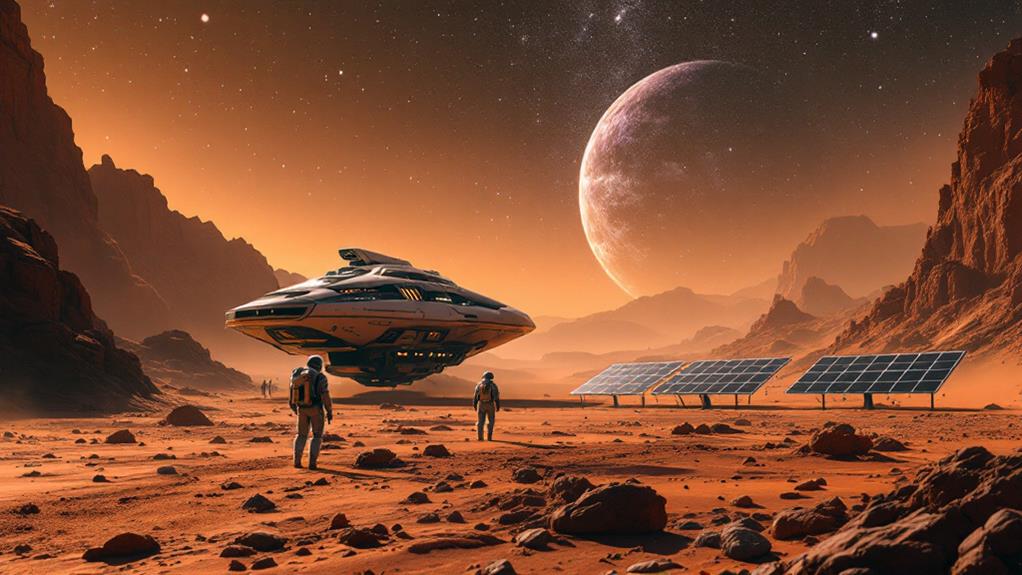Mars Rover – Curiosity: Exploring the Surface of the Red Planet
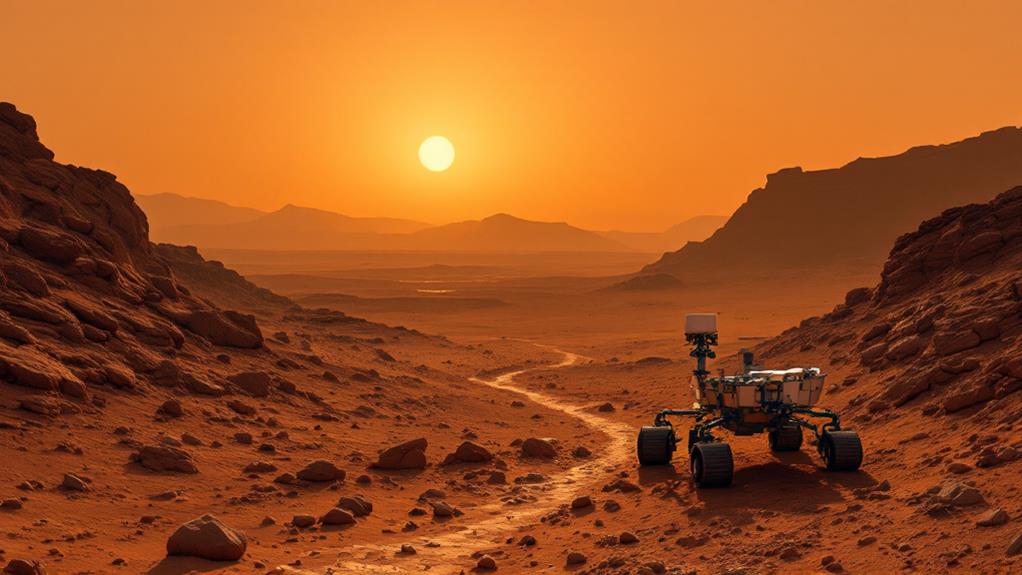
Your expedition with the Mars Rover Curiosity begins with its dramatic 2012 landing on the Red Planet using a revolutionary sky crane. As Curiosity traverses the Martian surface, it searches for signs of past microbial life and studies the planet's climate and geology. Equipped with advanced instruments like ChemCam and SAM, Curiosity analyzes rock and soil samples, revealing evidence of historical water presence and atmospheric conditions. Despite harsh challenges like dust storms and radiation, its findings reshape our understanding of Mars. Curious about how Curiosity navigates such an intriguing landscape and contributes to future exploration? There's much to reveal.
Curiosity's Landing on Mars
Touching down on the Martian surface on August 6, 2012, Curiosity's landing was a technological marvel that captured the world's attention. You're about to explore the intricate process that guaranteed this rover's safe arrival. The landing sequence, often referred to as the "seven minutes of terror," was a critical phase that required precise execution. As Curiosity approached Mars, it had to navigate the entry dynamics of the planet's thin atmosphere, using a heat shield to withstand temperatures of around 1,600 degrees Celsius.
Once the heat shield had done its job, the rover's descent stage initiated a complex sequence of events. A supersonic parachute deployed to slow Curiosity's rapid descent, but that was just the beginning. The rover separated from its back shell and, using a sky crane, was carefully lowered onto the Martian surface. The sky crane used thrusters for stability, making sure the rover didn't crash-land.
You can imagine the tension as mission control monitored every second. The success of this landing sequence relied on years of planning and testing, demonstrating human ingenuity and paving the way for exploration of the Red Planet.
Mission Objectives and Goals
As Curiosity set out on its mission, its primary objectives were clear and ambitious. You'd want to know that its main goal was to determine if Mars ever had the conditions necessary to support microbial life. To achieve this, Curiosity needed to analyze Martian soil and rock samples, searching for the chemical building blocks of life. Understanding Mars' climate and geology was also vital, as these insights could lead to significant scientific advancements in planetary science.
The mission timeline was carefully planned to guarantee Curiosity could thoroughly investigate the Martian surface. You'd be fascinated to see how it was designed to last at least one Martian year, which is nearly two Earth years. During this time, Curiosity aimed to provide valuable data on radiation levels, fundamental for future manned missions to Mars.
Another key objective was to identify water-related environments, both ancient and existing. By doing so, you'd appreciate how these findings could inform the search for life beyond Earth. Ultimately, Curiosity's mission sought to bridge gaps in our understanding of Mars, paving the way for future exploration and guaranteeing continuous scientific advancements.
Instruments and Technology
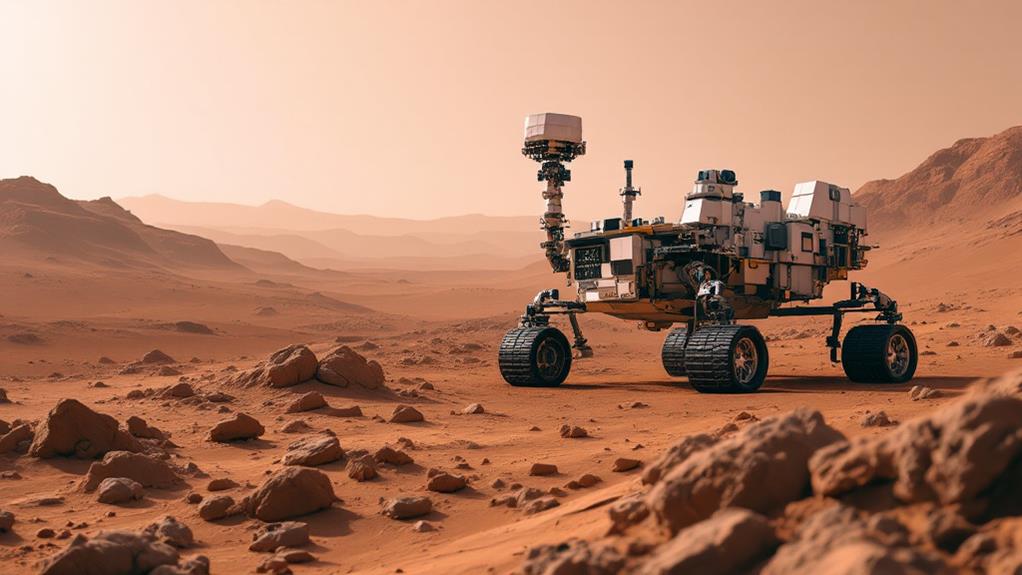
Curiosity's ambitious objectives required a suite of advanced instruments and cutting-edge technology to investigate the Martian environment effectively. As you examine Curiosity's capabilities, you'll find that it's packed with scientific instruments designed to analyze the Red Planet's surface. The rover's ChemCam, for instance, fires a laser at rocks, vaporizing them and analyzing the resulting plasma to understand their composition. This hands-off approach lets you gather significant data from a safe distance.
Another important tool is the Sample Analysis at Mars (SAM) suite. It examines soil and rock samples, helping you identify organic compounds and other fundamental elements. This suite is essential for revealing Mars's potential to support life. Meanwhile, the Mars Hand Lens Imager (MAHLI) provides close-up images of the Martian terrain, letting you scrutinize textures and structures with incredible detail.
Curiosity also boasts advanced technology like the Radiation Assessment Detector (RAD), which enables you to assess radiation levels, significant for future human exploration. The rover's ability to navigate rugged terrain autonomously showcases its cutting-edge technology. By utilizing these sophisticated tools, you can deepen your understanding of Mars's geology and climate, paving the way for future revelations.
Journey Through Gale Crater
Upon landing in August 2012, Curiosity began its ambitious expedition through Gale Crater, a fascinating landscape that has intrigued scientists for years. As you traverse this ancient Martian terrain, you uncover that it offers a window into Mars' past. The crater's geology is a mosaic of diverse rock formations, each layer telling a story of the planet's climatic evolution over billions of years. The central peak, Mount Sharp, rises majestically, challenging Curiosity to investigate its mysteries.
Curiosity's navigation through Gale Crater is no small feat. You must skillfully guide it across rocky terrains and sandy dunes, ensuring it stays on course towards scientific targets. The rover's autonomous capabilities allow it to make essential driving decisions, but your input is significant, especially when it encounters unexpected obstacles. You instruct Curiosity to analyze rock samples, and each result deepens your understanding of the crater's complex geology.
Every wheel rotation and data transmission is a step closer to unraveling Mars' secrets. As you continue this expedition, you appreciate how Curiosity's path through Gale Crater not only demonstrates technological prowess but also ignites human curiosity about the universe.
Discoveries and Findings
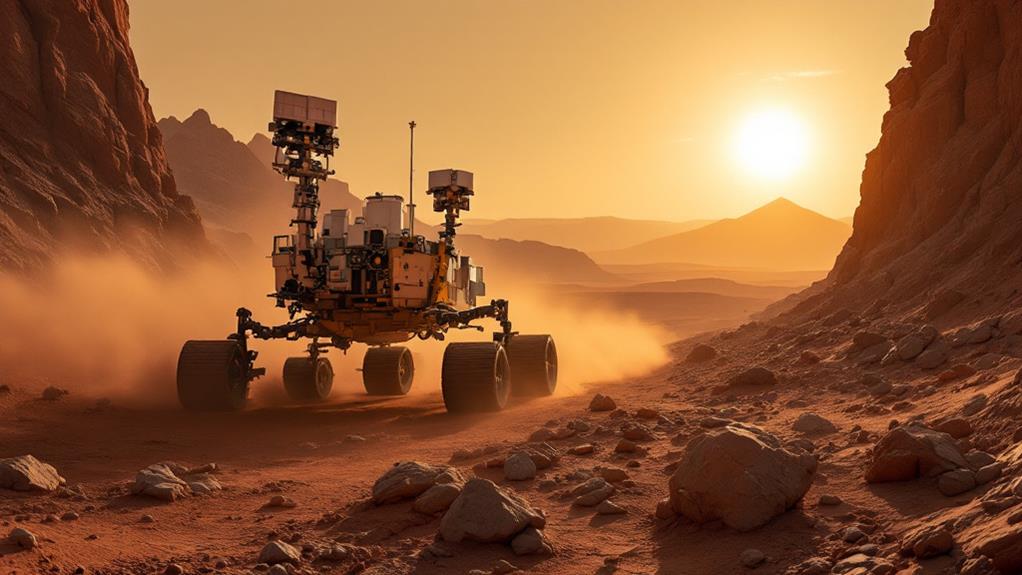
With each sample analyzed in Gale Crater, you reveal a wealth of Martian secrets, marking significant milestones in our understanding of the Red Planet. The revelations uncover diverse geological features that tell a story of Mars' dynamic past. Through advanced rover technology, you investigate surface compositions that suggest the historical presence of water, hinting at conditions that might have supported microbial life.
The Curiosity rover's findings have expanded our knowledge of atmospheric conditions, offering clues to the Martian climate. By studying the thin atmosphere, you learn about the processes that have shaped Mars over billions of years. The rover's instruments detect variations in gases like methane, raising intriguing questions about potential biological activity.
Your inquiry history with Curiosity has transformed planetary science, painting a more complex picture of Mars than ever before. Each revelation brings you closer to understanding the planet's capacity to harbor life. Through continuous examination of the Martian surface, you bridge the gap between Earth and Mars, unraveling mysteries that have puzzled scientists for generations. This mission isn't just about collecting data; it's about redefining our place in the cosmos and expanding the horizons of human knowledge.
Analyzing Martian Rock Samples
Exploring the heart of Mars, you focus on analyzing rock samples collected by the rover's drill. You begin by examining the rock composition, which offers insights into the Red Planet's geological history. Through sample analysis, you uncover a fascinating mineral diversity that helps piece together the environmental conditions Mars has experienced over millions of years.
You pay close attention to the chemical properties of the samples, as they reveal clues about the planet's past. By studying the surface textures, you can infer the processes that shaped these rocks, such as volcanic activity or sedimentary layering. Each detail contributes to a broader understanding of Mars' dynamic environment.
Isotopic ratios play a significant role in your analysis, as they can indicate the timeline of the rocks and the duration of certain geological processes. These ratios help you reconstruct a timeline of events that have defined Mars' surface and subsurface characteristics.
As you analyze these Martian rock samples, you realize that every piece of data improves our knowledge of Mars' complex history. The rover's findings not only expand our understanding of the planet but also inspire future exploration and exploration.
Signs of Ancient Water
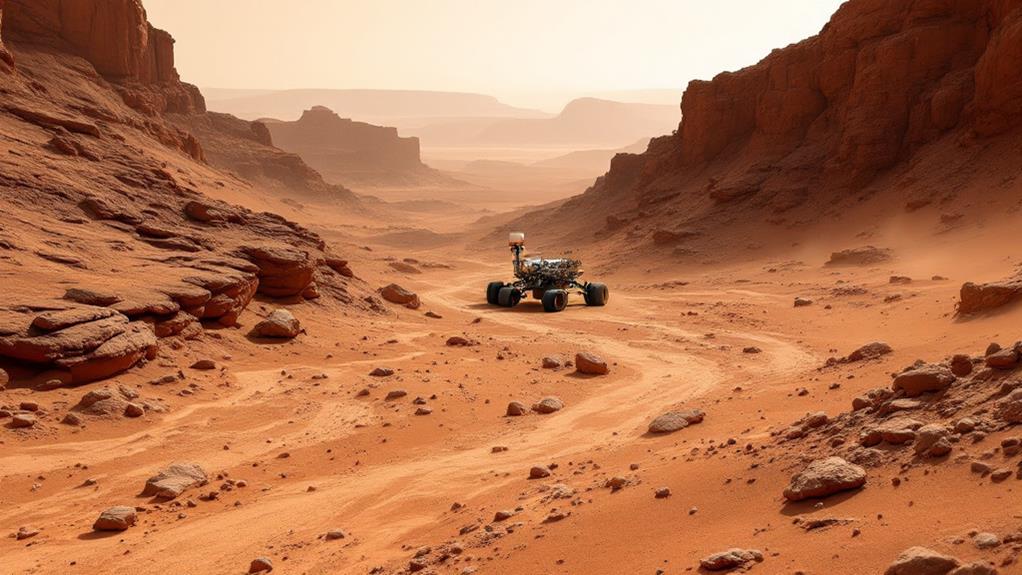
Building on the insights gained from the rock samples, you turn your attention to the tantalizing evidence of ancient water on Mars. Curiosity has uncovered compelling clues that suggest Mars once hosted flowing water. You investigate the landscape, observing features that hint at a period where water shaped the Martian terrain.
- Ancient Riverbeds: One of the most striking features are the remnants of ancient riverbeds. These channels, carved into the Martian surface, indicate that liquid water once coursed through them, potentially for long durations. They reveal the planet's dynamic hydrological past.
- Mineral Deposits: Curiosity's instruments have identified mineral deposits vital to understanding Mars' watery history. The presence of minerals like clays and sulfates suggests that water not only existed but also interacted with the Martian crust, altering its composition over time.
- Sedimentary Structures: The rover has also detected sedimentary structures, such as layered rocks. These formations are typically created in watery environments on Earth, offering further evidence that Mars' climate might have supported lakes or seas.
Challenges Faced on Mars
Exploring Mars often presents numerous challenges that test both technology and human ingenuity. You'll encounter massive dust storms that can obscure vision and interfere with solar panels, essential for energy. Mars' thin atmosphere and extreme temperature fluctuations make survival and operation difficult. Nighttime temperatures can plummet drastically, threatening both equipment and any potential human presence. Radiation exposure is another significant threat, given Mars lacks a magnetic field to shield you from cosmic and solar rays.
Communication delays pose a unique challenge as well. Signals take several minutes to travel between Earth and Mars, complicating real-time decision-making. You must plan with accuracy and anticipate issues before they arise. Resource limitations demand that you use every tool and piece of equipment efficiently, as resupply missions are incredibly complex and costly.
Navigation obstacles, such as uneven terrain and unpredictable surface geology, require creative solutions to guarantee your rover's safety. The rocky, cratered landscape can damage wheels and instruments if not carefully maneuvered. Finally, the atmospheric conditions on Mars present their own set of hurdles, affecting everything from landing procedures to ongoing exploration tasks. Each challenge you face requires adaptability and creativity to overcome.
Future Mars Exploration Plans
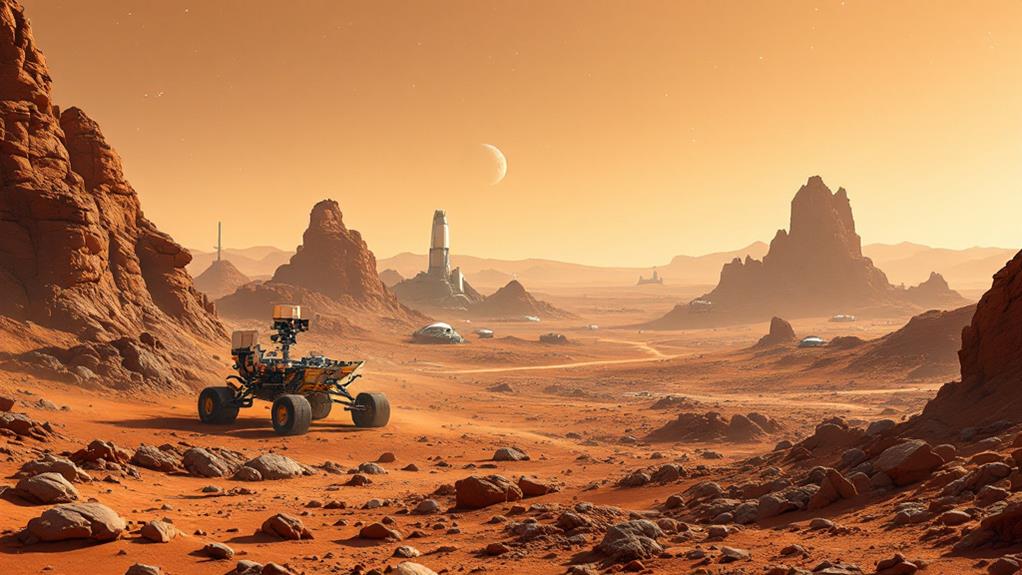
As humanity sets its sights on the next period of Mars investigation, a blend of cutting-edge technology and ambitious goals fuels the vision for future missions. You're looking at a future where human missions to Mars aren't just a dream but a reality. The focus is on Mars colonization, with sustainable habitats that support life long-term. International collaboration is vital, bringing together the world's best minds to tackle the challenges of interplanetary travel.
Future technologies play a significant role in these plans. Robotic explorers will continue to pave the way, gathering important data to make human missions safer and more efficient. You'll see advancements in terraforming Mars, a process that might one day make the planet more Earth-like. Space resources, such as water and minerals, will be harnessed to support life and fuel missions.
Here's a glimpse of the primary goals:
- Human and Robotic Partnerships: Combining human intuition with robotic precision to investigate Mars efficiently.
- Sustainable Living: Developing habitats and life support systems that use local resources.
- Long Term Goals: Establishing a presence that benefits future generations and opens the door to further space exploration.

